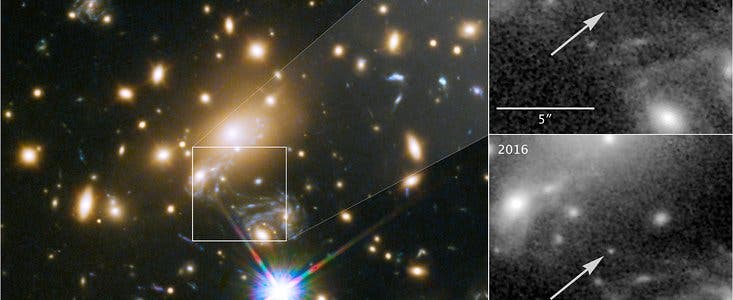A stroke of good fortune allowed astronomers to image a bright dot located a staggering 9 billion light-years away. This is the farthest star scientists have ever identified — more than 100 times more distant than any other lone star previously detected. Amazingly, the light we’re currently picking up first shot from the surface of the star ‘only’ 4.4 billion years after the Big Bang.

Typically, when astronomers image cosmic objects attsite:Zmescience.com such distances, they are very bright bodies like supernovae or galaxy clusters. How could a single, puny star shine as bright as a supernova (the most powerful explosions in the universe)? We just got very lucky — that’s all.
Thanks to a fortuitous cosmic alignment that enabled gravitational lensing, the star in question, called MACS J1149+2223 Lensed Star 1 (LS1), was magnified by a factor of 2,000. Famed physicist Albert Einstein predicted, as a result of his Theory of General Relativity, that whenever light from a distant star passes by a closer object, gravity acts like a magnifying lens bending the distant starlight but also brightening it. This effect has been documented extensively around very massive structures such as galaxies.
Initially, Patrick L. Kelly, an astrophysicist at the University of Minnesota, and colleagues were studying a supernova explosion in the galaxy cluster MACS J1149.5-223 when they picked up a strange blip that appeared in the same galaxy as the supernova. Since this first episode in April 2016, the astronomers were able to use the Hubble Space Telescope to image the hot blue star, which was magnified by a massive cluster of galaxies — the lens of the magnifying glass.
According to spectral measurements, LS1 is an extremely luminous and blue B-type supergiant star, whose surface temperature sits between 11,000 and 14,000 degrees Celsius. That’s more than twice as hot as the sun’s surface.
The astronomers were very lucky that the hot star passed right along the critical curve of the cluster, warping the starlight in our direction and enabling observations at unprecedented distances for a lone star. This effect is like a natural telescope, more powerful than anything we could ever build, according to Kelly.
LS1 will help scientists gain new insights into the constituents of the galaxy cluster. So far, Kelly’s team thinks the microlensing was caused by either a star, a neutron star, or a stellar-mass black hole. Learning about the constituents of galaxy clusters — some of the largest and most massive structures in the universe — will consolidate the science that studies the composition and evolution of the universe. And, as is often the case with such research, dark matter is always lurking.
“If dark matter is at least partially made up of comparatively low-mass black holes, as it was recently proposed, we should be able to see this in the light curve of LS1. Our observations do not favour the possibility that a high fraction of dark matter is made of these primordial black holes with about 30 times the mass of the Sun”, highlights Kelly.
Whatever the case may be, it’s quite amazing to look back in time at three-quarters of the universe’s age — all thanks to starlight and weird physics. In the future, coupling the same gravitational lensing technique with a far more powerful space telescope than Hubble — the upcoming James Webb Telescope — should allow scientists to peer ever further back in time.
The findings appeared in the journal Nature Astronomy.






